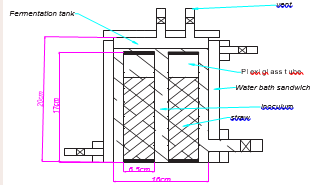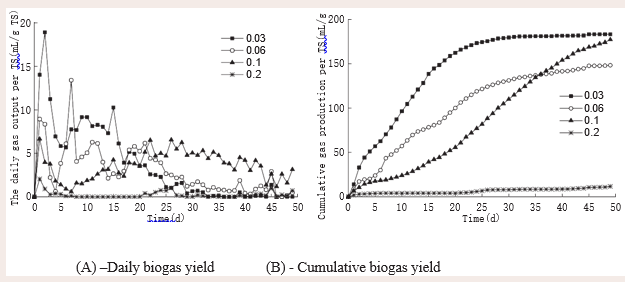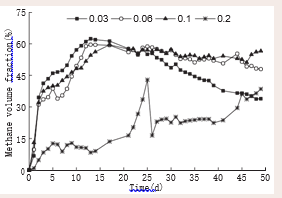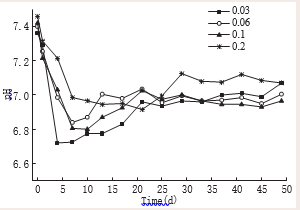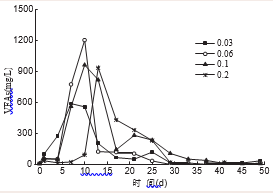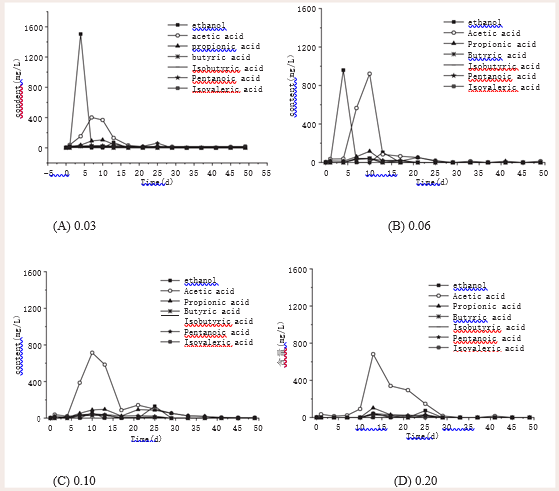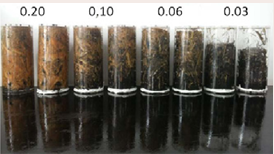Effect of Compaction on the Production of Biogas from Agricultural Straw
- 1. Anhui Engineering Laboratory of Soil and Water Pollution Control and Remediation, Wuhu 241002, China
- 2. College of Environmental Science and Engineering, Anhui Normal University, Wuhu 241002, China
- 3. College of Life Science, Anhui Normal University, Wuhu 241002, China
ABSTRACT
Solid-state anaerobic digestion is an important and growing method of producing biogas from biowastes with a high volume of solid contents. In this study we conducted laboratory experiments to examine the effect of compaction on biogas production processes from wheat straw. Daily and cumulative biogas yield, methane content, pH value, volatile fatty acids (VFAs) and organic matter loss rate were analyzed during the experiments with different bulk density. Because of self-settlement behavior, time of biogas production peak was delayed; biogas production peak, biogas production rate and organic matter loss rate were reduced. The loss rate of dry matter, cellulose, hemicellulose and lignin of wheat straw was inversely proportional to the bulk density of wheat straw, and the loss rate was in the order as follows: cellulose > hemicelluloses > lignin. The above results indicated that the biogas reactor height should be limited or appropriate engineering measures taken to reduce straw compaction, and thus reduction in biogas yield in agricultural straw biogas plants.
KEYWORDS
Straw; Biogas; Methane; Volatile fatty acids; Anaerobic fermentation.
CITATION
Chen G, Li J, Wang X (2020) Effect of Compaction on the Production of Biogas from Agricultural Straw. Chem Eng Process Tech 5(1): 1056.
INTRODUCTION
Agricultural straw (mainly from rice, wheat and maize), the main by-product of agricultural production, has characteristics of high yield, low moisture content, high lignification degree, and seasonal production. In 2014, China's total output of rice, wheat and corn straw reached 764 million tons. However, in recent years, the yield of wheat and corn straw has increased up to 764 million tons [1]. Due to the transformation of agricultural production modes and increasing shortages of rural labor, the need to find methods of comprehensive utilization of straw is becoming more and more serious. One such method is to convert agricultural straw into a clean energy source via the use of biotechnology, with methane as the main by-product. The fermented biogas sludge may then be returned to the field as organic fertilizer to realize the recycling utilization of straw resources, in line with the requirements of ecological agricultural production. This biotechnology is an important technical approach for comprehensive utilization of straw [2]. Due to the low moisture content of straw, it is necessary to adopt high solid or dry anaerobic fermentation technology. At present, batch anaerobic fermentation techniques, such as garage fermentation, red mud plastic membrane fermentation, trough fermentation and so on, are generally used in the biogas engineering of straw high solid or dry anaerobic fermentation.
In high solid anaerobic fermentation, processes of settlement and decomposition result in an increase in straw compactness, a decrease in porosity and a decrease in water and gas conductivitywithin the straw. This phenomenon is called self-compaction [3], and in the study of landfills, it is called sedimentation [4, 5]. In high solid anaerobic fermentation, the fact of material self-compaction exists, but the understanding of the impact of material self-compaction on anaerobic fermentation process is still lacking. At present, the research of solid-state anaerobic fermentation is mostly based on laboratory experiments. German garage-type fermentation is aimed at garden waste, and as the height of garage is not high, the self-compaction of materials is not obvious. Since the self-compaction of materials is mainly influenced by the height of the heap, the phenomenon is not obvious in the small scale fermenter of the laboratory. Only when the height of a material pile reaches a certain level does it become obvious, and begins to influence the chemical processes. This may be the reason why this problem has not been identified previously.
This paper explores the effects of self-compaction on methane production by anaerobic organisms in the high solid anaerobic fermentation of straw. Du Jing et al. [6], studied the characteristics of solid-state anaerobic fermentation of straw under pilot-scale conditions. It was found that after a period of fermentation, the straw in the middle and lower layers of the heap was compacted seriously, the compactness increased obviously, and the porosity decreased, regardless of whether the fermentation broth refluxed or not. After fermentation, there were significantly different VFA content of volatile solid state in the straw residues at different heights, which indicated that compaction had an effect on the anaerobic biotransformation of straw. The hydrolytic acid production characteristics of straw with different compactness were studied under laboratory conditions by Lv Lili [7]. The results showed that the hydrolysis rate of straw with bulk density of 0.08 t/m3 was significantly lower than that of straw with bulk density of 0.03 and 0.05 t/m3, respectively. The acid production type of straw was clearly affected by the compactness of straw. Acetic acid accounted for more than 80% in hydrolytic acidification solution of straw with bulk densities of 0.03 and 0.05 t/m3, and the content of propionic acid and butyric acid was very low. In comparison, the straw with bulk density of 0.08 t/m3 had much higher levels of butyric acid, propionic acid and water. This indicates that straw compaction had a significant effect on the type of hydrolytic acid production. These studies show that compaction does have an effect on anaerobic biogas production of straw, but it is not clear to what extent and in what specific manner it affects the anaerobic fermentation process.
In this study, we used wheat straw as the raw material to examine. We immersed varying densities of wheat straw in anaerobic liquid to undergo anaerobic fermentation and thus studied the characteristics of biogas fermentation, liquid fermentation and material loss, in order to explore the effects of straw compaction on anaerobic biogas production.
MATERIAL AND METHODS
Test materials
Wheat straw from wheat in Jiangsu Province Academy of Agricultural Sciences experimental field was air dried and mechanically crushed to 2-3cm lengths. With wheat straw, the dry matter test (total solid, TS) content is 91.90% and volatile solids (volatile solid, VS) content is 84.52%, C/N is 50.24.The inoculum pH value was 7.38, TS was 2.70%, and VS was 48.99%. The inoculum was domesticated in the laboratory, pH value is 7.38, TS is 2.70%, and VS is 48.99%.The substance content in the paper is the percentage of dry matter.
Test Methods
Firstly, a certain amount of straw is put into a plexiglass tube with a height of 17 cm and an inner diameter of 6.5 cm. There are several holes in the wall of the plexiglass tube, which allows for the flow of fermenting liquid inside and outside the tube. The plexiglass tube is provided with a bottom cover and a top cover for the purpose of fixing the experimental straw in the glass tube. Two organic glass tubes filled with wheat straw were loaded into a 5 L sequencing batch anaerobic fermentation tank (20 cm high, 16 cm in inner diameter and heated by a water bath jacket), 3L of the inoculum was added, the total mass of the fermented product was supplemented to 3.5 kg with water, the organic glass tube was completely immersed in the fermentation broth, and the anaerobic digestion experiment was performed at 37 ± 1 for 49 days. Based on the organic glass pipe, the amount of straw used was calculated according to dry matter bulk densities of 0.03ng / cm3 and 0.20 g / cm3 , respectively. The corresponding straw filling capacity (TS) in the anaerobic fermenter was 33.84g, 67.68g, 112.80g and 225.60 g, respectively, and the TS concentration in the fermentation tank was 0.97%, 1.933%, 2% and 6.45%, respectively. The average value of the three parallel treatments was taken for analysis.
During the experiment, gas production and methane volume fraction were measured every day, and pH values of VFAs, COD and SCOD were determined by fermentation broth at random during the experiment. After the test, straw was removed from the plexiglass tube to determine TS, VS and cellulose (total cellulose, hemicellulose and lignin) content.
Indicators and Methods for Determination
The volume fraction of methane in gas production was analysed by gas chromatography (GC 9890A, Nanjing Renhua Center for the Application and Development of Chromatography, Nanjing), and the TCD detector was used to determine the methane fraction. TS weight was determined by a differential weight method at 105 for 24 h. VS weight was determined by differential weight method at 550 for 4 h. Determination of pH value of fermentation broth was measured with the pHS-2F (Shanghai Precision Scientific instrument Co., Ltd., Shanghai). Organic carbon content was oxidized by potassium dichromate, and then heated to determine the final amount [8]. Total nitrogen was determined by the H2 SO4 -H2 O2 method and Kjeldahl method [9]. Determination of COD concentration was made with reference to GB1194-89. The content of cellulose, hemicellulose and lignin was determined by the normal form method [10], using the FIWE-6 cellulose instrument made in Italy. Individual volatile fatty acid content, including measures of acetic acid, propionic acid, butyric acid, isobutyric acid, valeric acid and isovaleric acid, was determined by gas chromatograph (GC-2014 SHIMADZU, Japan). A Stabil-Wax-DA 30m × 0.53mm × 0.25m capillary column detector was used. The temperature was programmed and 4-methyl pentanoic acid was used as the internal standard.
The loss rates of cellulose, hemicellulose and lignin in straw were calculated by the following formula:
(1)
In the above formula S is the loss rate, Tb is the dry matter weight of straw after anaerobic fermentation, Nb is the content of triglyceride after anaerobic fermentation, Ta is dry matter weight of straw before anaerobic fermentation and Na is the content of triglyceride before anaerobic fermentation.
Mapping and Statistical Analysis
Mapping was performed using Origin 8, Excel 2003 software processing of test data and SPSS 13 software for statistical analysis, with a confidence interval of 95% (P < 0.05).
RESULTS AND ANALYSIS
Effect of compaction on anaerobic biogas production of straw
Variation of daily gas production and cumulative gas production per unit TS straw: In this study, the amount of straw loading in different treatments is different, thus the daily gas production rate of straw cannot be directly compared. For this reason, the daily gas output of the reactor was converted into the daily gas production relative to the amount of dry matter straw per unit of treatment(It means that the amount of each TS in the fermentation tank is 1g of the daily output of straw). To facilitate the reader to read and understand Figure 1.
Figure 1: Experimental device.
During the test, the change in daily gas production of TS straw in each treatment unit was shown in Figure 2.
Figure 2: Changes of daily and cumulative biogas yield during experiments.
It can be seen that, except for the treatment with bulk density of 0.20 t/ m3 , the daily gas production of TS straw per unit of treatment is similar, with a pattern of rapid increase, then decrease, followed by further increase and then decrease: that is, there are two gas production peaks. This is consistent with the findings of other researchers [11,12] . At the beginning of the experiment, the treatments with a bulk density of 0.03, 0.06, 0.10 and 0.20 t/m3 reached the first peak of gas production on the second day of the experiment, with the peak values of 18.91, 8.93, 6.65 and 2.06 mL/(g•d), respectively. After that, the gas production gradually decreased, and reached a low point on the 7th and 8th day of the experiment, with values of 5.69 ,0.63 ,0.60 and 0 mL/(g•d), respectively. Gas production then displayed a second increase, and reached peak values of 10.27, 13.41, 6.56 and 1.02 mL/ (g•d) on the 15th day and the 26th day, respectively. After this it declined. The treatment with a bulk density of 0.20 t/m3 did not produce gas on the 8th day of the experiment. From the results of daily gas production, it can be seen that with an increase in the bulk density of straw, the rate of anaerobic biogas production of straw decreases. When the weight of the straw is up to 0.20t/m3 , the anaerobic biological biogas production of the straw organic substance is obviously inhibited, and the hydrolysis of the straw organic matter does not facilitate biogas production.
Figure 2 (b) shows the rate of accumulative gas production per unit TS straw during each treatment. It can be seen that the gas production rate of each treatment is quite different varies across the time course of the experiment. The overall trend was that the gas production rate decreased with the increase of straw bulk density. At the end of the experiment, the cumulative gas production of TS straw per unit with a bulk density of 0.03 ,0.06 , 0.10 and 0.20 t/m3 was 183.08, 148.21, 177.19 and 11.71 mL/g TS. The time required for the cumulative gas production of each treatment to reach 80% of total gas production may more be a more direct reflection of the gas production rate of the straw. The time required for the cumulative gas production to reach 80% of total gas production for bulk densities of straw of 0.03, 0.06, 0.10 and 0.20 t/m3 , was 17, 24, 37 and 43 days respectively, which indicated that the compaction had an inhibitory effect on the anaerobic biogas production of straw.
Changes of Methane Content
The volume fraction of methane in gas production can reflect the running condition of anaerobic fermentation experiment, and whether the test commenced normally. Figure 3
Figure 3: Changes of methane content during experiments.
shows the volume fraction of methane in each treatment. It can be seen that the volume fraction of methane produced by the treatment of 0.20t/m3 of straw bulk density increased slowly after the start of the experiment, and the volume fraction of methane for the other bulk densities increased rapidly. When the bulk density of straw was 0.03, 0.06 and 0.01 t/m3 , the methane volume fraction in gas production reached more than 50% on the 9th, 11th and 12th days, respectively. This indicates that straw compaction affected not only the gas production rate, but also the increase of methane volume fraction in gas production. After that, the volume fraction of methane in each treatment continued to increase, and the volume fraction of methane reached the maximum at 13, 13 and 17 days after the treatment with a bulk density of 0.03, 0.06 and 0.01 t/m3 , respectively. This correlates to a volume percentage of 62.42%, 59.59% and 59.53%, respectively. After this time,methane volume fraction decreased gradually. For the greater straw bulk density of 0.20 t/m3 , the volume fraction of methane in the gas production increased gradually to reach peak value of 42.91 on the 25th day of the experiment (as shown in Figure 2). The daily gas production in this stage also decreased to 16.42 at the peak of 26 days, and then increased. The results of methane volume fraction showed that straw compaction was not conducive to the anaerobic production of methane by straw organic matter. In addition the lack of organic matter in anaerobic fermentation system was also unfavorable to methane production.
Gas production characteristics
After 49 days of anaerobic digestion, the gas production results of each treatment are summarized in Table 1.
Table 1: Gas data of experiment.
|
index |
Straw bulk density (t/m3) |
|||
|
0.03 |
0.06 |
0.1 |
0.2 |
|
|
Cumulative gas production (mL) |
6196±783c |
10031±74b |
19987±250a |
2641±101d |
|
TS gas production (mL/g TS) |
183.08±23.1a |
148.21±1.10b |
177.19±2.21a |
11.71±0.45c |
|
Average methane content (%) |
48.61±0.45a |
47.53±0.52a |
52.37±0.26b |
20.66±0.67c |
|
TS methane production (mL/g TS) |
89.00±10.86a |
67.64±0.51b |
92.79±1.16a |
2.42±0.10c |
Note: The same row data marked same letters within same factors, indicate no significant difference (P>0.05), or have significant difference (P<0.05).
It can be seen that when the bulk density of straw is 0.03 ~ 0.10 t/m3 , the gas yield of straw is 148.21 ~ 183.08 mL/g TS, the methane production of TS was 67.64 ~ 92.79 mL/g TS, and the mean methane volume fraction in gas production was 47.53% and 52.37% respectively. When the bulk density of the straw was increased to 0.20 t/m3 , the yield of straw was obviously inhibited, the yield of the straw TS, the yield of the TS and the average methane volume fraction in the production gas were only 11.71 mL/g TS, 2.42 mL/g TS and 20.66 %, which were much lower than the other treatments. This demonstrates an inhibition of straw compaction on anaerobic biogas production.
Effect of compaction on characteristics of fermentation broth during anaerobic fermentation of straw
1. The anaerobic fermentation process of solid organic matter is divided into three stahydrolysis and dissolution of solid organic matter into macromolecular organic matter within fermentation broth,
2. transformation of macromolecular organic matter into small molecular organic acids,
3. conversion of small molecular organic acids to methane. Therefore, the determination of the physicochemical properties of fermentation broth can indirectly reflect the process of anaerobic fermentation of straw. This experiment measured the pH, VFAs concentration and composition of the fermentation broth.
Changes in pH value of fermentation broth: The pH value of the fermentation broth treated during the experiment is shown in Figure 4.
Figure 4: Changes in pH values during experiment.
It can be seen that the change of pH value in each treatment has a similar trend, which is that the pH value decreases rapidly at first, then increases slowly to reach relative stability. The pH values of the treatments with a bulk density of 0.03, 0.06, 0.10 and 0.20 t/m3 reached the lowest values on the fourth day of the experiment, at 6.72, 6.84, 6.80 and 6.92, respectively; and then increased gradually, and stabilized at 6.90~7.10, respectively. The results showed that straw compaction delayed the time of pH valley of fermentation broth, but the effect of straw compaction on final pH value was not obvious.
Total amount and Composition of VFAs in Fermentation Broth
VFAs and ethanol are intermediate products of anaerobic methane production from straw. There are many kinds of VFA. The contents of acetic acid, propionic acid, butyric acid, isobutyric acid, valeric acid and isovalerate acid were analysed in this experiment. The results of VFAs and ethanol concentration in the fermentation broth during the experiment are shown in Figure 5.
Figure 5: Changes of VFAs content during anaerobic digestion.
It can be seen that each treatment has a similar trend of change: initial increase and then decrease. The concentration of VFAs in the fermentation broth of each treatment increased rapidly, and the peak values of the treatments with a bulk density of 0.03, 0.06, 0.10 and 0.20 t/m3 were 587.00, 1200.20, 959.90 and 932.40 mg/L on the seventh, 10th, 10th and 13th days, respectively. After this it then decreased gradually. At the end of the experiment, the VFA content in the fermentation broth was within 35 mg/L.
There are many kinds of VFA produced by hydrolysis of straw, and the degree of conversion of VFA to methane varies greatly. Therefore, the composition of VFA in fermentation broth can be used to determine the type of acid production and the degree of difficulty in converting VFA to methane. The results of VFA components and ethanol concentration in the fermentation broth are shown in Figure 6.
Figure 6: Changes of content of volatile fatty acid composition and ethanol during experiments.
It can be seen that acetic acid is the main VFA produced, propionic acid is the second, and other components are very low. The results showed that the compaction process did not affect the type of acid produced in the fermentation of straw, but only affected substance exchange. When the bulk density of straw was 0.03 and 0.06 t/m3 , the ethanol content of fermentation broth showed a peak on the 5th day of experiment. This did not occur in the treatments with bulk density of 0.10 and 0.20 t/m3 , and the reasons for this phenomenon are not clear, and need further study. During the experiment, the acetic acid content in each treatment fermentation broth increased first and then decreased. The treatments with a bulk density of 0.03, 0.06, 0.10 and 0.20 t/m3 reached their maximum values at day seven, 10, 10 and 13, and were 401.50, 921.60, 714.90 and 682.00 mg / L, respectively. The results showed that straw compaction could delay the peak time of acetic acid production, but did not affect the concentration of acetic acid in the system, consistent with the impact of compaction on pH and VFA production.
Effect of compaction on material loss of anaerobic fermentation of straw
After anaerobic digestion, cellulose and hemicellulose in straw were decomposed into methane and carbon dioxide byproducts by anaerobic microorganism, and dry matter quality of straw decreased. In this experiment, the straw is filled in the plexiglass tube, and the straw in the glass tube is exchanged with the outside through holes in the side wall of the glass tube. The appearance of the organic glass tube after fermentation (see Figure 7)
Figure 7: The appearance of digested straw in organic glass tubes.
shows that the appearance of the straw in the plexiglass tube increases from black to yellow with increase of the bulk density of the straw. The results showed that straw compaction was not conducive to full contact between anaerobic microorganisms and straw in plexiglass tube. At the end of the experiment, the straw was removed from the plexiglass tube. Straw with a bulk density of 0.20 t/m3 showed obvious acidification in the plexiglass pipe. After fermentation, the straw was yellow and accompanied by strong acid taste, but the pH value of fermentation system was within a reasonable range. The low gas production for this density shows that the effect of compaction on straw gas production is mainly caused by the lack of full contact between straw and anaerobic microorganisms. This leads to poor material exchange inside and outside straw bundles, thus affecting the anaerobic biological transformation of straw. Treatment densities of 0.03 and 0.06 t/m3 resulted in the straw being arranged in a loose, naturally stacked state. Full contact between straw and anaerobic microorganisms is thus possible in the fermentation system. Therefore, the apparent color of straw after anaerobic fermentation was the same as that of the fermentation broth: dark black. The treatments with bulk densities of 0.03 and 0.06 t/m3 demonstrated a range of colours.
The content of cellulose, hemicellulose and lignin in straw after 49 days of anaerobic digestion is shown in Table 2.
Table 2: Changes of organic matter composition of straw obtained before and after anaerobic digestion (Unit: %).
|
index |
Pre-fermentation straw |
After fermentation |
|||
|
0.03 |
0.06 |
0.10 |
0.20 |
||
|
Hemicellulose content |
30.35±0.18a |
27.38±0.98b |
28.27±0.18b |
29.38±0.04ab |
30.82±0.29a |
|
Hemicellulose loss rate |
—— |
72.35 |
65.98 |
57.88 |
18.13 |
|
content of cellulose |
39.46±3.62a |
30.54±1.48b |
31.96±0.23b |
35.94±1.09b |
22.26±1.19c |
|
Cellulose loss rate |
—— |
76.28 |
70.42 |
60.39 |
54.52 |
|
Lignin content |
11.15±3.69a |
16.15±0.24b |
14.90±1.93b |
14.03±1.32b |
12.48±1.97b |
|
Lignin loss rate |
—— |
55.61 |
51.19 |
45.25 |
9.76 |
|
TS loss rate |
—— |
69.36±3.53a |
63.48±1.18b |
56.49±1.86c |
19.38±0.52d |
Note: The same row data marked same letters within same factors, indicate no significant difference (P>0.05), or have significant difference (P<0.05).
The content of triglycerides (TG) in straw reported here is the residual content of TG in the straw after anaerobic digestion. Its content cannot reflect the actual loss of TG before and after anaerobic fermentation, and can only be used as a reference index to evaluate the material composition and utilisation potential of straw after fermentation. As shown, after 49 days of anaerobic digestion, the content of cellulose and hemicellulose in the straw decreased, and the lignin content increased. When the bulk density of straw was 0.20 t/m3 the content of cellulose decreased the most, which was related to the acidification of the straw, showing that the lower pH value was favorable to the hydrolysis of cellulose [13]. In the process of anaerobic fermentation of solid organic matter, the decomposition of solid organic matter includes conversion of solids to methane and carbon dioxide gas, and dissolution of some organic and inorganic substances into anaerobic fermentation broth. Therefore, the dry matter loss rate of solid organic matter after anaerobic fermentation is not absolutely consistent with its gas production. After anaerobic digestion for 49 days, the TS loss rates of the treatments with a bulk density of 0.03, 0.06, 0.10 and 0.20 t/m3 were 69.36%, 63.48%, 56.49% and 19.38%, respectively. The results were similar to those of gas production, but not completely consistent. The TS loss rate of the treatment with a bulk density of 0.06 t/m3 was higher than that of the treatment with a bulk density of 0.10 t/m3 , but the gas production was lower than that of the latter. This may be due to the fact that the total amount of straw is lower than that of the latter, which results in a higher proportion of straw organic matter used in the synthesis of anaerobic microorganism.
The loss rate of straw TG after anaerobic fermentation can be calculated by combining the results of straw TG content with TS loss rate before and after anaerobic fermentation. It can be seen from the results in Table 2 that the cellulose, hemicellulose and lignin contents in the straw have been greatly lost after anaerobic digestion. The most rapid loss was that of cellulose followed by hemicellulose and then lignin, and the loss rate of cellulose, hemicellulose and lignin is inversely proportional to the compactness of straw. The results showed that straw compaction was not conducive to anaerobic biogas production of straw, which was consistent with the results of gas production in our experiment. It may be concluded that lignin could not be decomposed and utilized by anaerobic microorganisms during anaerobic fermentation. Although anaerobic fermentation cannot destroy the lignin structure in straw, the decomposition of cellulose and hemicellulose cause lignin fragments to enter into fermentation broth in large quantities, thus producing a measured loss of straw lignin [14].
DISCUSSION
The essence of anaerobic fermentation of straw to produce biogas is the process of decomposition and utilization of cellulose and hemicellulose by anaerobic microorganisms to methane and carbon dioxide. The core of this process is the activity of anaerobic microorganisms and thus it is necessary that straw is in full contact with them. In high solid or dry anaerobic fermentation of straw, straw sedimentation occurs due to a decrease in mechanical strength of straw, and the impact of gravity. This manifests in increased compaction. From the results of this experiment, compaction is not conducive to the entry of anaerobic microorganism into straw, and it inhibits their full contact with the straw. Thus, compaction is also not conducive to the exchange of substances inside and outside the straw bundle. On the one hand, the straw acidification in the organic glass tube is serious; on the other hand, the organic matter which can be decomposed by anaerobic microorganism in the anaerobic fermentation system is deficient.
In this experiment, the volume fraction of methane produced by straw with a bulk density of 0.03t/m3 was greatly reduced between the period of 14 days to the end of the test. The decrease from 62.42 % at the peak was 33.92 % at the end of the trial, which was echoes the results of previous studies. It is speculated that in the late stage of the experiment, the decomposable organic matter in the straw has been decomposed and utilized extensively, resulting in a relative shortage of organic matter which can be quickly decomposed and utilised for anaerobic fermentation. The activity of methanogenic bacteria was inhibited and the volume fraction of methane in gas production decreased [15].
From the study of the pH values of fermentation broth, the experiment did not show a correlation between higher the bulk densities of straw and lower the pH values. We postulated that this is because, in this experiment, the straw is in a separate plexiglass tube, and that there was material exchange through the holes in this tube. Therefore, the greater the amount of straw loading in the plexiglass pipe, the more difficult it is to hydrolyze and dissolve the organic matter from the straw in the plexiglass pipe. The results showed that although the amount of straw in anaerobic reactor was the largest when the bulk density of straw was 0.20 t/m3 , the pH value was not the lowest because the organic matter in the straw could not be hydrolyzed and dissolved in time. In addition, at the end of the experiment, the plexiglass tubes in the anaerobic fermenter treated by each treatment were removed, and the treatment with a bulk density of 0.20 t/m3 was accompanied by a strong acid smell. This suggests that the acid production of straw hydrolysis was not being completed in the experimental period, resulting in delayed biogas production.
During anaerobic fermentation of solid organic matter, the concentration of VFAs in fermentation broth exhibits dynamic change, as the of hydrolytic acidification of solid organic matter proceeds. Therefore, the change of its concentration can only give an indication of the efficacy of fermentation, rather than describing a direct linear relationship to the efficacy of the process. However, from the results of VFAs treatment, the anaerobic fermentation process of each treatment was normal, which was not consistent with the results of gas production. It is further explained that the means by which compaction affected the anaerobic biotransformation of straw was by preventing the internal and external exchange of substances, not directly affecting the anaerobic fermentation system itself (and thus not directly affecting the type of VFA production.)
CONCLUSION
1) The effect of straw compaction on anaerobic biogas production is obvious. The results showed that the peak gas production time was delayed, and the peak gas production and gas production rate were decreased. The biomass densities of straw in the experiment produced biogas in the range of 0. 03 ~ 0. 10 t/m 3, and when the bulk density of straw was more than 0. 20 t/m 3 , straw gas production was obviously inhibited.
2) Straw compaction has obvious negative effects on the decomposition of organic matter in straw. The loss rate of dry matter, cellulose, hemicellulose and lignin in straw is inversely proportional to the bulk density of straw. The order of loss rate was cellulose > hemicellulose > lignin.
3) Straw compaction mainly inhibited straw anaerobic biogas production by blocking the contact between straw and anaerobic microorganisms and the material exchange inside and outside the straw column, and had no significant effect on pH value or VFA content in the anaerobic fermentation system.
ACKNOWLEDGEMENTS
This research was sponsored by Natural Science Foundation of Anhui Province (Grant no. 1808085ME132).
REFERENCES
- National Bureau of Statistics, China Statistical Yearbook 2015.
- Zhang LJ, Yi F, Zhao Xingling, et al. Utilization of Biogas Fermentation with Straw in Chinese Eco-agriculture. Modern Agricultural Science and Technology, 2013; 16: 263-264.
- Z.Z. Chang, Adrie Veeken. Effects of temperature on the structure of a compost bed- Compress, porosity and permeability. Journal of Agro- environmental Science, 2004; 23: 791-795.
- Yue B, Chen TB, Zheng GD, et al. Study on pile surface settlements and volume reduction ratios during sewage sludge composting. Chinese Journal of Environmental Engineering, 2011; 5: 2849-2853.
- Xie Q. A Study on the Settlement of Sanitary Landfill of Municipal SolidWaste. Ph.D. Dissertation of Chongqing University, Chongqing, 2004.
- Du Jing, Zhu Dewen, Qian Yuting, Chen Yongsheng, Chen Guangyin, Chang Zhizhou. Effect of gas guide measurement and leachate- recirculation on gas production from dry fermentation. Transactions of the Chinese Society for Agricultural Machinery. 2013; 44: 143–148.
- Lv LL. Research on optimization parameters for hydrolysis acidification of bundling wheat straw. Master dissertation of Nanjing Agricultural University, Nanjing, 2013.
- NY525 - 2002 Agricultural Industrial Standards for Agricultural Industry of the People’s Republic of China _ Organic Fertilizer Standard( Organic Fertilizer Standard ) , 2002 .
- Bao SD. Soil Agrochemical Analysis. Version 3. Beijing: China Agricultural Press. 2000: 39 – 69.
- Yang S. Feed analysis and feed quality monitoring technique. Beijing: Beijing Agricultural University Press, China.
- Li Dong, Ma LongLong, Yuan ZhenHong, Li LianHua, Sun YongMing. Experimental study on dry anaerobic digestion of rice straw at ambient temperature in South China. Transactions of the CSAE, 2006; 22: 176-179.
- Chen GY, Du J, Chang ZZ, et al. Study on anaerobic co-digestion of agricultural straw and swine wastewater based on straw-bed bioreactor. Transactions of the CSAE. 2014; 30: 244251.
- Li SJ. Hydrolytic techniques of Plant Fiber. Beijing: chemical Industry Press, China.
- Chen GY, Cao J, Ye XM, et al. Effect of pH values control on biogas production of agricultural straw with two-phase anaerobic fermentation. Ecology and Environmental Sciences, 2015; 24: 336-342.
- Liu DJ, Zhang XX, Rao XJ. Biogas production comparison of different crop straws under dry anaerobic fermentation. China Biogas, 2015; 33: 54-56.
